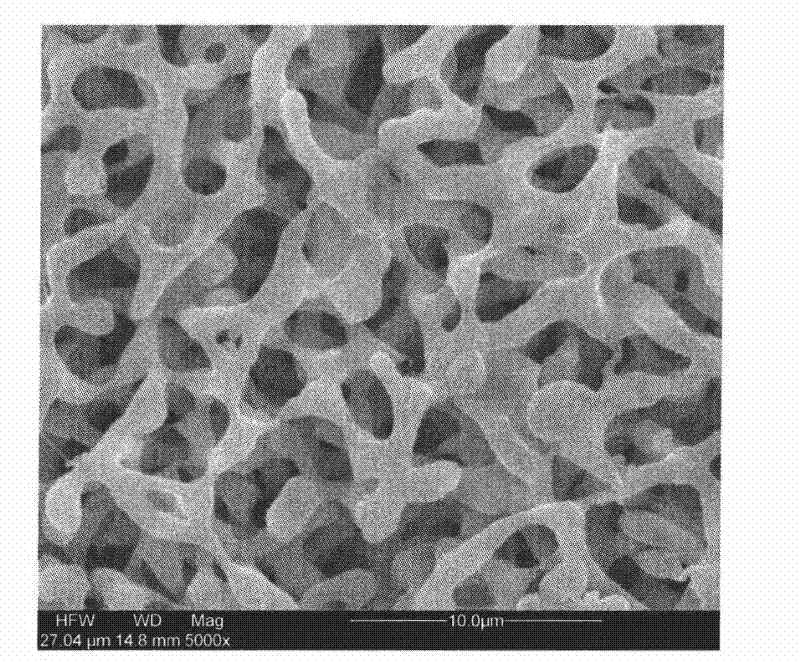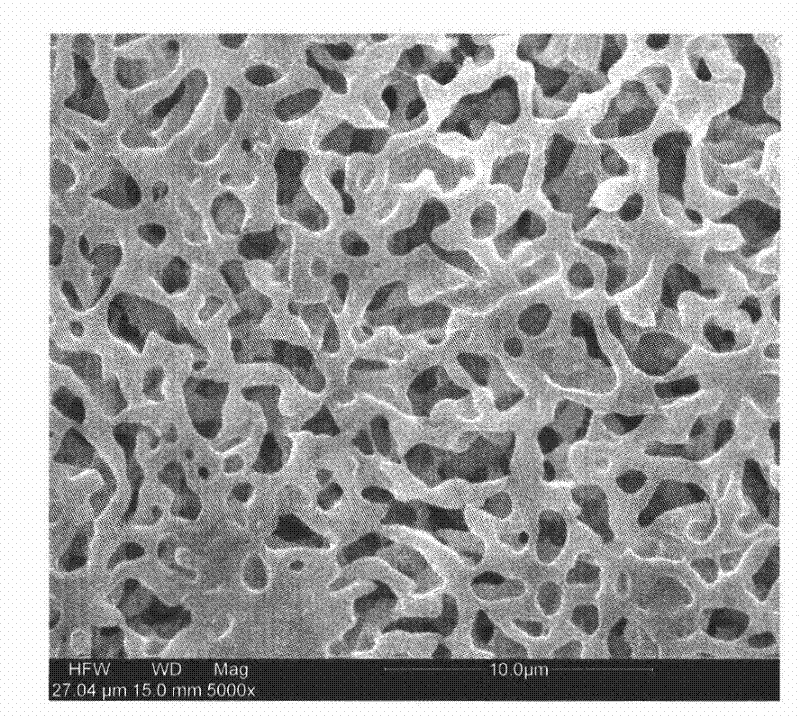Polyionic liquid base micropore quasi solid state electrolyte preparation method and application
A technology of polyionic liquid and ionic liquid, which is applied in the field of solid electrolyte preparation technology, can solve the problems of reducing the mechanical strength of the polymer, difficulty in battery packaging, and increasing the short circuit of the battery, so as to achieve the goals of not easy to leak, reduce leakage and volatilization, and improve safety Effect
- Summary
- Abstract
- Description
- Claims
- Application Information
AI Technical Summary
Problems solved by technology
Method used
Image
Examples
Embodiment 1
[0025] In the first step, weigh 1 mol of N-vinylimidazole and 1 mol of 1-iodopropane, mix them evenly, put them into a reactor lined with polytetrafluoroethylene, seal the reactor, and heat up. After the autoclave was kept at 120°C for 4h, the autoclave was taken out; after the autoclave was cooled to room temperature, the product was taken out, and the excess iodinated alkane was washed away with ether solvent, and the residual ether solvent was removed by vacuum drying at 80°C for 24h to obtain 1-vinyl-3- Propyl imidazole iodide salt.
[0026] In the second step, weigh 5g of 1-vinyl-3-propylimidazole iodide salt, dissolve it in 10ml of ethanol solvent, add 2wt% azobisisobutyronitrile as initiator, N 2 After 30 hours of polymerization at 60°C under protection, the product was vacuum dried at 80°C for 24 hours to remove the ethanol solvent to obtain a polymerized ionic liquid.
[0027] In the third step, weigh 0.1g polymerized ionic liquid, 0.9g polyvinylidene fluoride, and 1.4g gl...
Embodiment 2
[0031] In the first step, weigh 1 mol of N-vinylimidazole and 1.2 mol of 1-iodopropane, mix them evenly, put them into a reactor lined with polytetrafluoroethylene, seal the reactor, and heat up. After the autoclave was kept at 100°C for 6h, the autoclave was taken out; after the autoclave was cooled to room temperature, the product was taken out, and the excess iodinated alkane was washed away with ether solvent, and the residual ether solvent was removed by vacuum drying at 80°C for 24h to obtain 1-vinyl-3- Propyl imidazole iodide salt.
[0032] In the second step, weigh 10g of 1-vinyl-3-propylimidazole iodide salt, dissolve it in 25ml of ethanol solvent, add 6wt% azobisisobutyronitrile as initiator, N 2 The polymerization reaction was conducted at 80°C for 10 hours under protection, and the product was vacuum dried at 80°C for 24 hours to remove the ethanol solvent to obtain a polymerized ionic liquid.
[0033] In the third step, weigh 0.3g polymerized ionic liquid, 0.7g polyvin...
Embodiment 3
[0037] In the first step, weigh 1 mol of N-vinylimidazole and 1.5 mol of 1-iodopropane, mix them evenly, put them into a reactor lined with polytetrafluoroethylene, seal the reactor, and heat up. After the autoclave was kept at 70°C for 8h, the autoclave was taken out; after the autoclave was cooled to room temperature, the product was taken out, and the excess iodoalkane was washed away with ether solvent, and the residual ether solvent was removed by vacuum drying at 80°C for 24h to obtain 1-vinyl-3- Propylimidazole iodonium salt.
[0038] In the second step, weigh 15g of 1-vinyl-3-propylimidazole iodide salt, dissolve it in 45ml of ethanol solvent, add 10wt% azobisisobutyronitrile as initiator, N 2 The polymerization reaction was carried out at 70°C for 24 hours under protection, and the product was vacuum dried at 80°C for 24 hours to remove the ethanol solvent to obtain a polymerized ionic liquid.
[0039] In the third step, weigh 0.6g polymerized ionic liquid, 0.4g polyvinyli...
PUM
 Login to View More
Login to View More Abstract
Description
Claims
Application Information
 Login to View More
Login to View More - R&D
- Intellectual Property
- Life Sciences
- Materials
- Tech Scout
- Unparalleled Data Quality
- Higher Quality Content
- 60% Fewer Hallucinations
Browse by: Latest US Patents, China's latest patents, Technical Efficacy Thesaurus, Application Domain, Technology Topic, Popular Technical Reports.
© 2025 PatSnap. All rights reserved.Legal|Privacy policy|Modern Slavery Act Transparency Statement|Sitemap|About US| Contact US: help@patsnap.com



